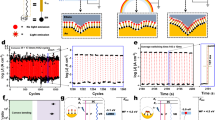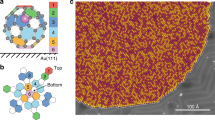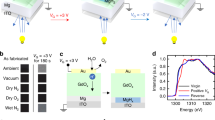Abstract
The development of a variety of nanoscale applications1,2 requires the fabrication and control of atomic3,4,5 or molecular switches6,7 that can be reversibly operated by light8, a short-range force9,10, electric current11,12 or other external stimuli13,14,15. For such molecules to be used as electronic components, they should be directly coupled to a metallic support and the switching unit should be easily connected to other molecular species without suppressing switching performance. Here, we show that a free-base tetraphenyl-porphyrin molecule, which is anchored to a silver surface, can function as a molecular conductance switch. The saddle-shaped molecule has two hydrogen atoms in its inner cavity that can be flipped between two states with different local conductance levels using the electron current through the tip of a scanning tunnelling microscope. Moreover, by deliberately removing one of the hydrogens, a four-level conductance switch can be created. The resulting device, which could be controllably integrated into the surrounding nanoscale environment, relies on the transfer of a single proton and therefore contains the smallest possible atomistic switching unit.
This is a preview of subscription content, access via your institution
Access options
Subscribe to this journal
Receive 12 print issues and online access
$259.00 per year
only $21.58 per issue
Buy this article
- Purchase on Springer Link
- Instant access to full article PDF
Prices may be subject to local taxes which are calculated during checkout





Similar content being viewed by others
References
Browne, W. R. & Feringa, B. L. Making molecular machines work. Nature Nanotech. 1, 25–35 (2006).
Balzani, V., Credi, A. & Venturi, M. Molecular machines working on surfaces. ChemPhysChem 9, 202–220 (2008).
Eigler, D. M., Lutz, C. P. & Rudge, W. E. An atomic switch realized with the scanning tunnelling microscope. Nature 352, 600–603 (1991).
Repp, J., Meyer, G., Olsson, F. E. & Persson, M. Controlling the charge state of individual gold adatoms. Science 305, 493–495 (2004).
Quaade, U. J., Stokbro, K., Thirstrup, C. & Grey, F. Mechanism of single atom switch on silicon. Surf. Sci. 415, L1037–L1045 (1998).
Donhauser, Z. J. et al. Conductance switching in single molecules through conformational changes. Science 292, 2303–2307 (2001).
Iancu, V. & Hla, S-W. Realization of a four-step molecular switch in scanning tunneling microscope manipulation of single chlorophyll-α molecules. Proc. Natl Acad. Sci. USA 103, 13718–13721 (2006).
Wolf, M. & Tegeder, P. Reversible molecular switching at a metal surface: a case study of tetra-tert-butyl-azobenzene on Au(111). Surf. Sci. 603, 1506–1517 (2009).
Loppacher, C. et al. Direct determination of the energy required to operate a single molecule switch. Phys. Rev. Lett. 90, 066107 (2003).
Moresco, F. et al. Conformational changes of single molecules induced by scanning tunneling microscopy manipulation: a route to molecular switching. Phys. Rev. Lett. 86, 672–675 (2001).
Henzl, J., Mehlhorn, M., Gawronski, H., Rieder, K-H. & Morgenstern, K. Reversible cis–trans isomerization of a single azobenzene molecule. Angew. Chem. Int. Ed. 45, 603–606 (2006).
Liljeroth, L., Repp, J. & Meyer, G. Current-induced hydrogen tautomerization and conductance switching of naphtalocyanine molecules. Science 317, 1203–1206 (2007).
Pivetta, M., Ternes, M., Patthey, F. & Schneider, W-D. Diatomic molecular switches to enable the observation of very-low-energy vibrations. Phys. Rev. Lett. 99, 126104 (2007).
Wäckerlin, C. et al. Controlling spins in adsorbed molecules by a chemical switch. Nat. Commun. 1, 61 (2010).
Qiu, X. H., Nazin, G. V. & Ho, W. Mechanisms of reversible conformational transition in a single molecule. Phys. Rev. Lett. 93, 196806 (2004).
Dolphin, D. (ed.) The Porphyrins (Academic, 1978).
Scudiero, L., Barlow, D. E. & Hipps, K. W. Physical properties and metal ion specific scanning tunneling microscopy images of metal(II) tetraphenylporphyrins deposited from vapor onto gold(111). J. Phys. Chem. B 104, 11899–11905 (2000).
Auwärter, W. et al. Site-specific electronic and geometric interface structure of Co-tetraphenyl-porphyrin layers on Ag(111) Phys. Rev. B 81, 245403 (2010).
Spillmann, H. et al. A two-dimensional porphyrin-based porous network featuring communicating cavities for the templated complexation of fullerenes. Adv. Mater. 18, 275–279 (2006).
Écija, D. et al. Hierarchic self-assembly of nanoporous chiral networks with conformationally flexible porphyrins. ACS Nano 4, 4936–4942 (2010).
Heim, D. et al. Self-assembly of flexible one-dimensional coordination polymers on metal surfaces. J. Am. Chem. Soc. 132, 6783–6790 (2010).
Écija, D. et al. Assembly and manipulation of rotatable cerium porphyrinato sandwich complexes on a surface. Angew. Chem. Int. Ed. 50, 3872–3877 (2011).
Nazin, G. V., Qiu, X. H. & Ho, W. Visualization and spectroscopy of a metal-molecule-metal bridge. Science 302, 77–81 (2003).
Hennig, J. & Limbach, H-H. Kinetic study of hydrogen tunnelling in meso-tetraphenylporphine by nuclear magnetic resonance lineshape analysis and selective T1ρ-relaxation time measurements. J. Chem. Soc. Faraday Trans. 2 75, 752–766 (1979).
Butenhoff, T. J. & Moore, C. B. Hydrogen atom tunneling in the thermal tautomerism of porphine imbedded in a n-hexane matrix. J. Am. Chem. Soc. 110, 8336–8341 (1988).
Lastapis, M. et al. Picometer-scale electronic control of molecular dynamics inside a single molecule. Science 308, 1000–1003 (2005).
Martin, M. et al. Mastering the molecular dynamics of a bistable molecule by single atom manipulation. Phys. Rev. Lett. 97, 216103 (2006).
Seufert, K. et al. Cis-dicarbonyl binding at cobalt and iron porphyrins with saddle-shape conformation. Nature Chem. 3, 114–119 (2011).
Sperl, A., Kröger, J. & Berndt, R. Controlled metalation of a single adsorbed phthalocyanine. Angew. Chem. Int. Ed. 50, 5294–5297 (2011).
Sarhan, A., Arboleda, N. B. Jr, David, M., Nakanishi, H. & Kasai, H. STM-induced switching of the hydrogen molecule in naphtalocyanine. J. Phys. Condens. Matter 21, 064201 (2009).
Fu, Q., Yang, J. & Luo, Y. Mechanism for tautomerization induced conductance switching of naphthalocyanin molecule. Appl. Phys. Lett. 95, 182103 (2009).
Baker, J., Kozlowski, P. M., Jarzecki, A. A. & Pulay, P. The inner-hydrogen migration in free base porphyrin. Theor. Chem. Acc. 97, 59–66 (1997).
Braun, J., Hasenfratz, C., Schwesinger, R. & Limbach, H-H. Free acid porphyrin and its conjugated monoanion. Angew. Chem. Int. Ed. 33, 2215–2217 (1994).
Ghosh, A. First-principles quantum chemical studies of porphyrins. Acc. Chem. Res. 31, 189–196 (1998).
Maity, D. K., Bell, R. L. & Truong, T. N. Mechanism and quantum mechanical tunneling effect on inner hydrogen atom transfer in free base porphyrin: a direct ab initio dynamics study. J. Am. Chem. Soc. 122, 897–906 (2000).
Acknowledgements
The authors thank J. Repp for helpful suggestions concerning the data analysis. The work was supported by the ERC Advanced Grant MolArt (no. 247299), TUM-IAS and the Munich Center for Advanced Photonics (MAP). N.S. acknowledges a scholarship from DAAD. D.E. thanks the European Commission for support through the Marie Curie IntraEuropean Fellowship for Career Development FP7 programme.
Author information
Authors and Affiliations
Contributions
K.S., W.A., F.B., D.E., S.V., S.J. and N.S. performed the STM experiments and analysed and interpreted the experimental data. F.K. supported the data analysis and contributed to the NEXAFS experiments. W.A., K.S. and J.V.B conceived the studies and co-wrote the paper.
Corresponding author
Ethics declarations
Competing interests
The authors declare no competing financial interests.
Supplementary information
Supplementary information
Supplementary information (PDF 1178 kb)
Rights and permissions
About this article
Cite this article
Auwärter, W., Seufert, K., Bischoff, F. et al. A surface-anchored molecular four-level conductance switch based on single proton transfer. Nature Nanotech 7, 41–46 (2012). https://doi.org/10.1038/nnano.2011.211
Received:
Accepted:
Published:
Issue Date:
DOI: https://doi.org/10.1038/nnano.2011.211
This article is cited by
-
The role of aromaticity in the cyclization and polymerization of alkyne-substituted porphyrins on Au(111)
Nature Chemistry (2023)
-
Voltage-driven control of single-molecule keto-enol equilibrium in a two-terminal junction system
Nature Communications (2023)
-
Internal Stark effect of single-molecule fluorescence
Nature Communications (2022)
-
Atomic-scale visualization of chiral charge density wave superlattices and their reversible switching
Nature Communications (2022)
-
Electron dynamics of tip-tunable oxygen species on TiO2 surface
Communications Materials (2021)



